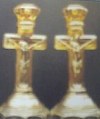Carnival Glass 101 | home Quick Reference to Carnival Glass Patterns on This Site
Dugan - Part 18
DUGAN GLASS – Part 18
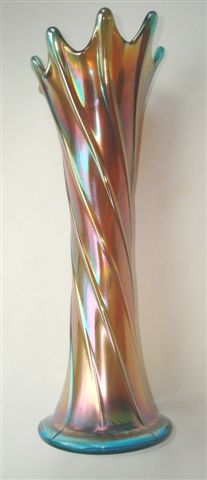
10 5. in. SPIRALEX Vase. Sapphire.
Courtesy Kate and Bill Lavelle
SPIRALEX Vase: Listed in Dugan catalogs as #1028, the carnival version appears from 1910 through the early 1920s. Heights range from 8”-14” tall, with most examples found in the 9”-12” size range. White vases are not easily found. Cobalt blue is a rare color. Marigold, amethyst and peach opal are the more prevalent colors.
In 1916, Diamond produced a Cerulean blue and one called Vesuvius blue in 1924. Collectors have labeled them “celeste blue”. Sapphire blue is basically the same base glass color we refer to as Celeste. Although the base glass color is somewhat more intense, the main difference is in the iridescence. Celeste blue examples have an onionskin stretchy effect, while Sapphire examples offer a satiny, multi-color iridescence closely resembling the effect we see on other carnival pieces. This color was made by Diamond from around 1916. They are rarely found.
You may view other examples in this pattern by clicking into – S -- in our pattern alphabet on the homepage.
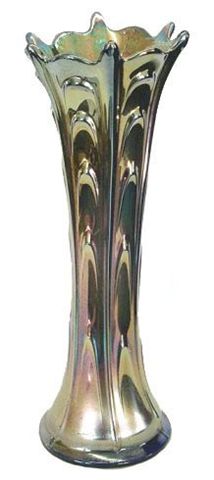
Blue PULLED LOOP - 11 in. high.
PULLED LOOP Vase: Blue is the rarest of colors in this pattern. White and peach opalescent are difficult to locate. Marigold and amethyst seem to be most available. You may view other colors in this pattern by clicking into – P -- in our pattern alphabet on the homepage.
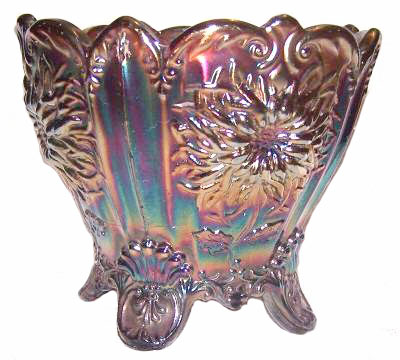
DAHLIA Spooner in Amethyst -
4 in. tall x 4.5 in. wide at opening.
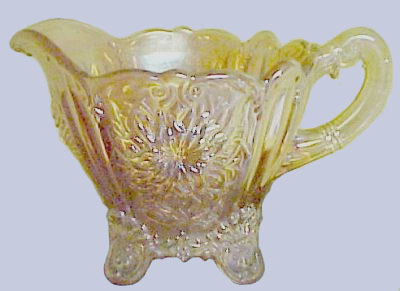
DAHLIA Creamer - Marigold.
DAHLIA: This Dugan design dates from the 1912 timeframe. It is found in berry set, table set, and water set. Marigold, amethyst, and white are the known colors. White pieces are most popular, bringing the higher prices, they are actually the more available color. Red or gold trim, and sometimes with fired-on blue and gold trim are specialty features and usually exhibit fine iridescence! A bit of research indicates fewer marigold and amethyst sets than white are available.
L.G. Wright Glass Co. reproduced the Dahlia water set in iridized, as well as non-iridized blue opalescent. Mosser Glass Co. made reproductions of the water set in red, pink opalescent, sapphire blue, and black amethyst. Some of the colors are iridized and some are not. New tumblers have only three Dahlia flowers, instead of the original four. Old tumblers have a 33 rayed star on the underside of the base. New ones are plain.
Excepting the white and amethyst pieces, none of the other colors was ever made in the originals.
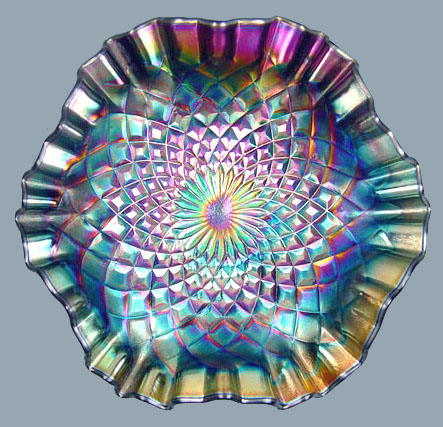
FOLDING FAN Compote in Amethyst - Quite Rare!
FOLDING FAN: These short-stemmed compotes are among the more scarce patterns in the Dugan arena. More peach opal present themselves than marigold and amethyst examples are downright scarce! To date, no white examples are known. The usual crimped edge compliments the overall diamond design. These can be banana shaped as well. Only four or five are known in amethyst, the last one selling publicly in 2011 for more than $300.
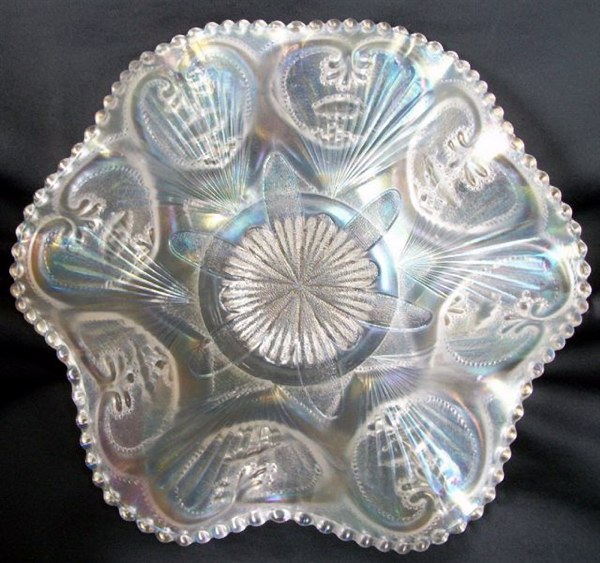
VERY RARE! White 9 in. Ruffled PETAL & FAN.
PETAL & FAN Bowl: One of the early Dugan patterns, peach opalescent examples having appeared in the Fall 1910 Butler Bros. catalog. It continued to appear through the Spring 1911 issue. Jeweled Heart exterior pattern always accompanies the design. Peach Opal ruffled bowls are seen more often in today’s world, with amethyst berry sets being quite scarce. White sets are very rare and quite underrated. Marigold is the scarcest color. The master berry bowl measures at least 10” in diameter, while some 8”-9” ruffled bowls have been documented in peach opalescent, amethyst, white and marigold. 6”-7” crimped edge plates in amethyst and peach opal, along with a banana bowl of 5”-6” in peach opal are also to be found.
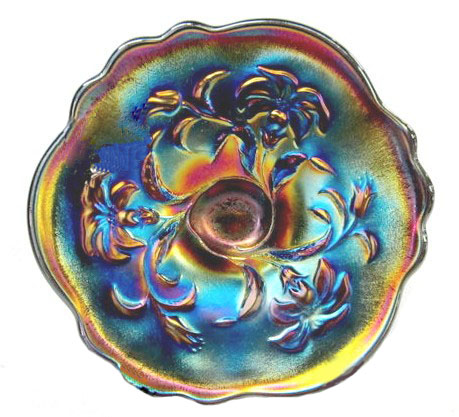
AMARYLLIS (Plate) Amethyst.
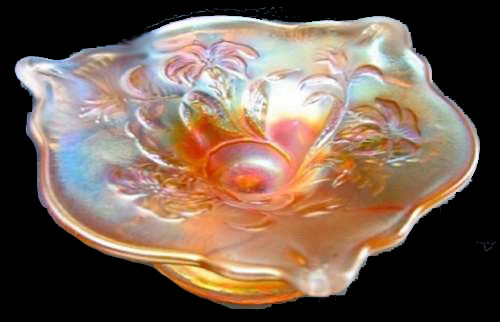
AMARYLLIS (Plate) Marigold.
AMARYLLIS: A non-iridescent production of Poppy Wreath appears in the 1907 Dugan factory catalog. Utilized as the exterior design for these intriguing little compotes adds interest for pattern collectors. Gorgeous examples of this lovely Dugan design are found in white, along with some cobalt blue ones. There are known ruffled, triangular, or deep round shapes. Plate forms in marigold, amethyst and white are quite desirable.
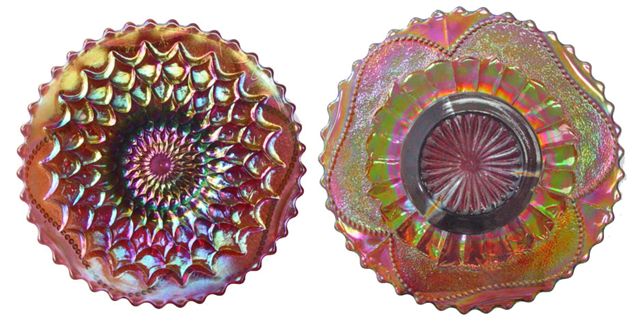
FISHSCALE and BEADS - Amethyst.
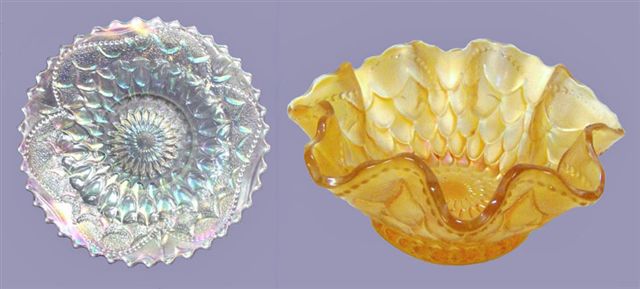
FISHSCALE and BEADS - 6 in. White Plate and Marigold Bowl.
FISHSCALE & BEADS: The Flower and Beads exterior pattern adds considerably to the overall appreciation for this 5”-7” size pattern. Existence of the exterior design indicates previous use of the mold in production of opalescent glass. Dugan and Diamond created a long run of this pattern.
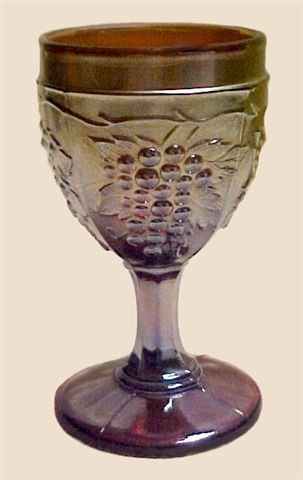
Golden Harvest Wine - Amethyst.
GOLDEN HARVEST Wine: The Golden Harvest decanter in amethyst can be seen in our DUGAN - DIAMOND – PART 2. Both marigold and amethyst examples in these sets are extremely scarce. Perhaps since Diamond Glass did not introduce them until 1916, the basic excitement for such sets had waned?
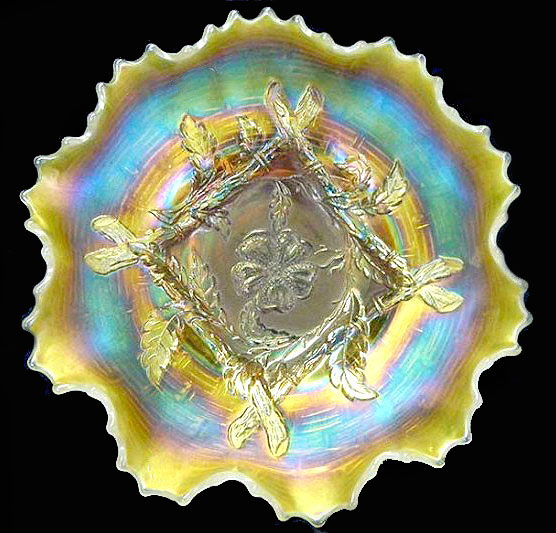
Apple Blossom Twigs Bowl in Peach Opal.
APPLE BLOSSOM TWIGS Bowl: One of the hallmarks of Dugan - Diamond examples is that there are so many and varied applications of color. This aspect makes grouping a number of peach opal examples together, somewhat impossible. Those same variations exist in Northwood aqua opal selections. Grouped together, they suddenly are not quite so attractive! The differences can be intense, as seen in this bowl, or it can be quite pastel with the opal barely showing on the edge. An interesting aspect of this design: 9” bowls and plates can be found having either smooth edge and plain exterior or fluted edge and Big Basketweave exterior.
Dean & Diane Fry, 12-12
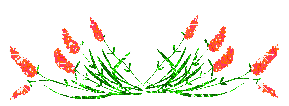
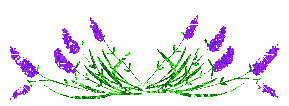

Have you made that noble request: “Lord, what would you have me to do?”
Requests for health, healing, success, and even spiritual power are not wrong, but they can become selfish prayers if they do not flow from a heart determined to obey God. Jesus said, “He who has My commandments and keeps them, It is he who loves Me. And he who loves me will be loved by My Father” (John 14:21)



Should you care to contact the Frys, their email address is:
Search Carnival Glass 101
back to Carnival Glass 101
Our other sites you may enjoy:
Everything you EVER wanted to know about Indiana Glass
Great Reference for Newer Carnival Glass.
Complete Glassware Catalogs Available to Download
Questions? Comments? Suggestions? Broken Links? Corrections?
Your Friendly Webmaster is here to help!
